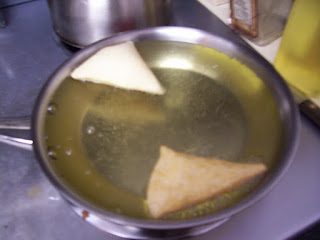Today I'm making good on my threat to teach you how to make sopapillas, a type of Mexican frybread.
As usual, you don't get the recipe without wading through some of my family history: My father ran a dragline when I was little, and his oiler was a Mexican American fellow named Joe Gray (but with a Spanish pronunciation: roll the r and pronounce the ay as aye). His wife's name was Romelia, and if you've read Counting the Cost, you've read the description of this lovely lady.
One summer we were on a highway project in northern New Mexico, and we camped out all summer in the woods near Ojo Caliente. Every morning, Romelia would make tortillas, and mother would let me go watch her. I always came away with a warm tortilla, and ever since that time, tortillas have been comfort food.
But, back to sopapillas. Romelia made those, too. I called them sofa pillows and thought they were the most lovely thing I had ever eaten. I was disappointed to find, when we left New Mexico, that Mexican restaurants in Arizona and California didn't serve them.
They're simple to make. Here's how:
This recipe will make about 16 2" x 3" sopapillas.
2 cups white flour
2 tsps baking powder
1/2 tsp salt
2 tablespoons shortening
2/3 cup
warm water

Cut the shortening into the flour. I used a food processor, but you can use the whip or beaters on a mixer. Add salt and baking powder and mix. Then add the water and continue to mix. Your dough should be soft but will make a ball that will hold its shape. Knead for a minute and then separate into four balls and let it rest for 10 minutes.
In the meantime, take a small pot or skillet and put 2 to 2 1/2 inches of oil in the bottom and heat to about 375 degrees. I don't have a thermometer, so I just put it on high and when the oil gets hot enough, I start turning it down. I usually end up with it between medium and medium high. The oil should bubble up instantly when the dough is put in. If the sopapilla doesn't fill with air, your oil isn't hot enough.

Roll one of the balls of dough out to about 1/8 inch thick. You should not have to flour your rolling surface or the rolling pin.

Cut your flattened dough into four diamond-shaped pieces and drop them into the hot grease. They should swell up into little pillows. If they don't immediately, hold them under the hot grease for a few seconds, and they should pop up and start swelling.
When golden brown on one side, turn the sopapilla over to brown on the other. When it's done, lift it out onto a paper towel to drain.

Sopapillas are best eaten warm with honey, jam or powdered sugar on them.
The two sopapillas pictured at the bottom left are ones that were cooked before the oil was hot enough. They are flat rather than puffed up.
~~~~~~~~~~~~~~~~~~
I've taught sopapillas, but I've got to teach you how to make flour tortillas. You'll need a rolling pin made out of a 1 1/2 dowel or a piece of conduit like the one pictured above. Make friends with an electrician and see if you can get one. It needs to be 6" long.
And...be sure you don't miss out on the next recipe, review, scrap of wisdom or pithy thought. Become a follower on this blog by clicking on the
Join this Site button on the sidebar. Check out my books behind the
Liz's Books tab at the top, or read reviews of my latest book under the
Reviews tab.

